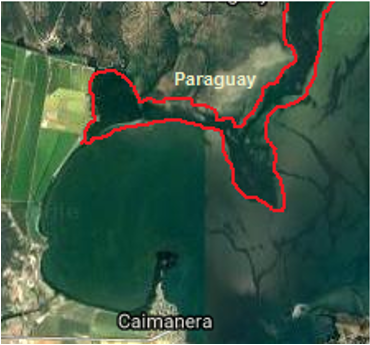Proposal of actions to recover the mangrove forest in the Guantánamo bay, Cuba
Main Article Content
Abstract
Downloads
Article Details
References
CAPOTE R. P Y BERAZAIN R.1984. Clasificación de las formaciones vegetales de Cuba. Revista del Jardín Botánico Nacional Universidad de la Habana 5(2):2775
CÁRDENAS DEL ÁNGEL, S.I., 2014. ENSAYOS DE REFORESTACIÓN EN UN ÁREA DEGRADADA DE MANGLAR EN EL SITIO RAMSAR No.1602 [en línea]. Tesis de Maestría Inédita. México: Universidad Veracruzana, Campus Tuxpan. Disponible en: https://www.uv.mx/pozarica/mmemc/files/2012/10/SANDRA-IVONNE-CARDENAS-DEL-ALGEL.pdf.
COSTA-ACOSTA, J., CASTELL-PUCHADES, M.Á., GONZÁLEZ-OLIVA, R., REYES-DOMÍNGUEZ, O.J. y QUINTANA-ÁLVAREZ, L.O., 2014. CARACTERIZACIÓN Y SALUD DEL MANGLAR EN EL REFUGIO DE FAUNA EL MACÍO, GRANMA, CUBA. Ciencia en su PC [en línea], no. 4. [Consulta: 24 abril 2018]. ISSN 1027-2887. Disponible en: http://www.redalyc.org/resumen.oa?id=181335576001.
CRUZ CABEZAS, M.A., 2003. Metodología para mejorar el nivel de formación de las habilidades profesionales que se requieren para un desempeño profesional competente en la especialidad Construcción Civil [en línea]. Tesis presentada en opción al grado científico de Doctora en Ciencias de la Educación. Holguín: Universidad de la Holguín, Instituto Superior Pedagógico José de la Luz y Caballero. Disponible en: http://repositorio.uho.edu.cu/jspui/handle/uho/2754.
ESPÓSITO VERDEJO, M. 2003 Diagnóstico Rural Participativo. Una guía práctica. 1ra ed. Centro Cultural Proveda. Santo Domingo. ISBN: 99934-24-10-2.
GEILFUS, F. 2009, 80 Herramientas para el desarrollo participativo: Diagnostico, Planificación, Monitoreo, Evaluación. 8va ed. Instituto Interamericano de Cooperación para la Agricultura. El Salvador, ISBN13: 999237727-5.
GUZMÁN MENÉNDEZ, J. M. y MENÉNDEZ CARRERA, L. 2013 Protocolo para el monitoreo del ecosistema de manglar. 1a ed. La Habana: Centro Nacional de Áreas Protegidas ISBN: 978-959287-042-0.
GUZMÁN TORRES, A. y COYA DE LA FUENTE, L., 2014. ENFOQUES, ACCIONES Y RESULTADOS SOBRE LA CONSERVACIÓN Y RESTAURACIÓN DE ECOSISTEMAS EN CUBA. [en línea]. Taller de desarrollo de capacidades a nivel de Mesoamérica sobre conservación y restauración de ecosistemas en apoyo al cumplimiento de los Objetivos Aichi de…. San José: Costa Rica. [Consulta: 12 noviembre 2016]. Disponible en: https://slidedoc.es/enfoques-acciones-y-resultados-sobre-la-conservacion-y-restauracion-de-ecosistemas-en-cuba-pdf.
LEYVA, O.R., 2016. Estado actual del bosque de manglar en el lote 2 de la Reserva Ecológica Baitiquirí, Guantánamo. Revista Cubana de Ciencias Forestales, vol. 4, no. 2, pp. 207-219. ISSN 2310-3469.
MENÉNDEZ, L., 2013. El ecosistema de manglar en el archipiélago cubano: bases para su gestión [en línea]. Tesis presentada en opción de grado Científico de Doctor en Ciencias. España: Universitat d'Alacant - Universidad de Alicante. [Consulta: 2 abril 2018]. Disponible en: https://dialnet.unirioja.es/servlet/tesis?codigo=59555.
RODRÍGUEZ LEYVA, O.; FALCÓN OCONOR, E.; FERNÁNDEZ PÉREZ, M.C.; RODRÍGUEZ LEYVA, E. y ROMERO CASTILLO, C. V. 2014 Estado actual del bosque de manglar en el sector costero Caimanera. Revista electrónica «Hombre, Ciencia Tecnología», 34(71). 10-25 ISSN 1028 08712014
VARGAS-FONSECA, E., 2015. Capacidad de regeneración natural del bosque de manglar del Estero Tortuga, Osa, Puntarenas, Costa Rica. Rev. Biol. Trop., vol. 63, pp. 11.
VÉLEZ, L.F.L. y POLANÍA, J., 2005. Estructura y dinámica del manglar del delta del río Ranchería, Caribe colombiano. Revista de Biología Tropical [en línea], vol. 55, no. 1. [Consulta: 24 abril 2018]. ISSN 2215-2075. DOI 10.15517/rbt.v55i1.6053. Disponible en: https://revistas.ucr.ac.cr/index.php/rbt/article/view/6053.


